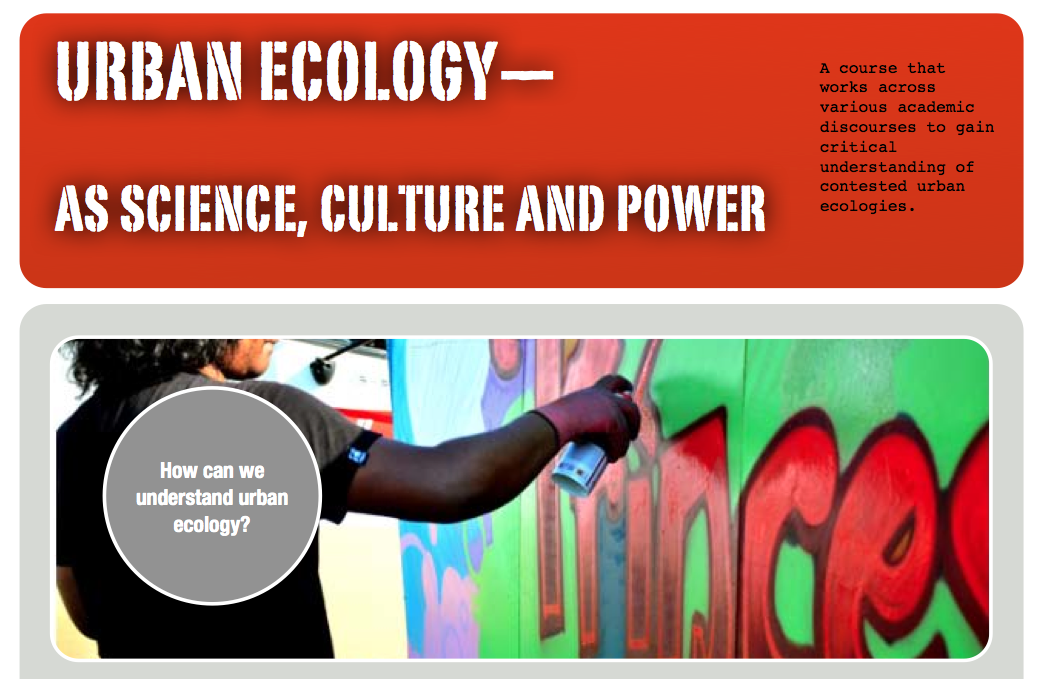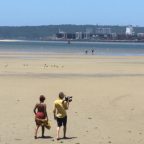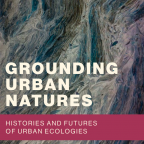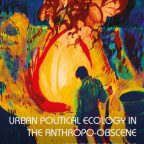Literature PhD course: Urban Ecology as…
Literature list for ‘Urban Ecology as Science, Culture and Power’ (Version 3)
The course is based upon intense reading across a large field of literatures. With the intensification of increased urbanization and ecological crises, there has been an enormous academic production that has engaged with the notions of ‘urban ecology’ and ‘urban nature’. Some has been in the realm of basic science, some in the field sciences; other expressions has been towards policy—natural resource management and urban planning—and politics.
Below is a selection and does not try to be comprehensive. However, there are structuring features of these literatures that the course strives to unpack, and every article is thus, in that sense, an example—or case study—of a larger field. Through getting familiar with this literature, we will touch and discuss the larger fields and strive to unpack what it is that makes them operate and ‘tick’. This will help all participants the better situate their own work in the literature, and get inspired, or provoked, by fields they knew less about before the course.
What follows is a first set of readings that you can start with. The selection tries to find a balance between theoretical interventions, and case study research. This serves to sensitize the course to how theoretical statements are made, but also how empirical phenomenon are researched. The headings are provincial but gives a marker in which broad area of the literature they fit in. A couple of more headings will be added with some other literature. Also non-compulsory literature will be added later on. Most articles and chapters you can find in the course DropBox. I will continue adding as I have made scanned versions. The only book you really need to buy is Richard Walker’s (see below). But of course several are useful, for instance Cronon (1991) and Lachmund (2012).
The articles are divided between ‘empirical engagements’ and ‘theoretical interventions’, which is, again, only a marker for things that works across these borders. But the point out a main thrust of the papers.
All non-marked are compulsory reading. *Compulsory and part of reading for a lecture **Non-compulsory reading.
As Science… To understand how the social practice of science tries to make sense of urban ecology as vegetation patterns, movement of species and as entire ecosystems.
Empirical engagements (case studies)
Lundberg, J., Andersson, E., Cleary, G., Elmqvist, T., 2008, Linkages beyond borders: targeting spatial processes in fragmented urban landscapes, Landscape Ecology 23(6):717-726.
**Zipperer, W. C., Guntenspergen, G., 2009, Vegetation composition and structure of forest patches along urban-rural gradients, in: Ecologies of Cities and Towns: A Comparative Approach (M. J. McDonnell, A. K. Hahs, J. H. Breuste, eds.), Cambridget University Press, Cambridge.
Theoretical interventions
Grimm, N. B., Faeth, S. H., Golubiewski, N. E., Redman, C. L., Wu, J., Bai, X., Briggs, J. M., (2008) Global Change and the Ecology of Cities, Science 319:756-760. [5 pages; ](Summarizing article.)
Pickett, S. T. A., Cadenasso, et al. (2008) Beyond urban legends: An emerging framework of urban ecology, as illustrated by the Baltimore Ecosystem Study, Bioscience 58(2):139-150. (Presenting a framework. Distilling a mode of thinking about the urban.)
**Pickett, STA and Cadenasso ML (2006) Advancing urban ecological studies: Frameworks, concepts, and results from the Baltimore Ecosystem Study. Austral Ecology 31, 114–125
…and as Systems Theory, NRM and SES… To understand how ‘field science’ is translated into policy and management ideas around urban ecology.
Empirical
Colding, J., Lundberg, J. and Folke, C. (2006) Incorporating green-area user groups in urban ecosystem management. Ambio 35(5) 237-244.
Empirical and theoretical
Barthel, S., Folke, C., and Colding, J. (2010) Social-ecological memory in urban gardens—Retaining the capacity for management of ecosystem services. Global Environmental Change 20: 255-265.
Ernstson, H., Barthel, S., Andersson, A. and Borgström, Sara T. (2010) Scale-crossing brokers and network governance of urban ecosystem services: The case of Stockholm. Ecology and Society 15(4): 28
As Culture… To understand how to use cultural geographical theory to understand and approach urban biophysical processes and ‘urban nature’, including STS and ‘science-in-action’ with focusing on different ways of knowing urban ecologies.)
Empirical engagements
Karvonen, A., & Yocom, K. (2011). The civics of urban nature: enacting hybrid landscapes. Environment and Planning A, 43(6), 1305–1322. doi:10.1068/a43382 (* Connects with Hinchliffe and Whatmore but in a more straightforward way. Better situated in environmental history and UPE).
*Evans, J. (2011) Resilience, ecology and adaptation in the experimental city. Transactions of the Institute of British Geographers 36: 223-37.
*Evans, J. (2007) Wildlife corridors: an urban political ecology. Local Environment 12 (2) 129-152.
*Ernstson, H. (2011) Re-translating nature in post-apartheid Cape Town: The material semiotics of people and plants at Bottom Road. In: Heeks, R., (Ed.) Conference on “Understanding Development Through Actor-Network Theory”, London School of Economics, 30 June, London, URL: http://bit.ly/Re-translating_Nature_LSE. [15 pages] (* Connects with Hinchliffe and Whatmore, draws more upon ANT, and introduces urban ecology in a racialized landscape, postapartheid.)
Ernstson, H., & Sörlin, S. (2009). Weaving protective stories: connective practices to articulate holistic values in the Stockholm National Urban Park. Environment and Planning A, 41(6), 1460–1479. doi:10.1068/a40349
Theoretical interventions
*de Certeau, M. (1984) The Practice of Everyday Life, University of California Press, Berkeley. Chapter 7. Walking in the City.
Hinchliffe, S., & Whatmore, S. (2006) Living cities: Towards a politics of conviviality. Science as Culture, 15(2), 123–138. [15 pages] (* Links very well with the urban ecology as science through citing ecologists about the recombinant ecology.)
Hinchliffe, S., Kearnes, M. B., Degen, M., Whatmore, S., 2005, Urban wild things: a cosmopolitical experiment, Environment and Planning D: Society and Space 23:643-658. (Goes against the UPE scholars notion of where the political lies and how to enact it.)
As History… To understand how historical methods and ways of structuring accounts and arguments brings a layered story to urban ecology.
Empirical engagements (the only mode of historical research…)
Karvonen, A. (2010). MetronaturalTM: Inventing and reworking urban nature in Seattle. Progress in Planning, 74(4), 153–202. doi:10.1016/j.progress.2010.07.001
Lachmund, J. (2012). Greening Berlin. Princeton: MIT Press. (*Selected empirical chapter-*)
Walker, R. (2007) The Country in the City: The Greening of The San Francisco Bay Area, Univ of Washington Press, Seattle and London. (135 pages to read) — Introduction and Chapters 3-7 —
**Cronon, W. (1991). Nature’s Metropolis: Chicago and the Great West. New York: Norton. (Chapter 4)
As Power… To understand how, in particular, critical geography and neo-Marxist thought have aimed to politicize urban ecology, its benefits and ills, and how it is known. Also often historical, but more explicitly driven by theoretical ideas.
Empirical engagements
Swyngedouw, E. (1997). Power, nature and the city: The conquest of water and the political-ecology of urbanization in Guayaquil. Environment and Planning A, 29(2), 311–332.
Gandy, M. (2006). Planning, Anti-planning and the Infrastructure Crisis Facing Metropolitan Lagos. Urban Studies, 43(2), 371–396. doi:10.1080/00420980500406751
Ernstson, H., & Sörlin, S. (2013). Ecosystem services as technology of globalization: On articulating values in urban nature. Ecological Economics, 86, 274–284. doi:10.1016/j.ecolecon.2012.09.012
Theoretical interventions
Swyngedouw, E. (1996). The City As a Hybrid: On Nature, Society and Cyborg Urbanization. Capitalism Nature Socialism, (April 2013), 37–41.
Swyngedouw, E. (2009). The Antinomies of the Postpolitical City: In Search of a Democratic Politics of Environmental Production. International Journal of Urban and Regional Research, 33(3), 601–620. doi:10.1111/j.1468-2427.2009.00859.x
Gandy, M. (2005). Cyborg Urbanization: Complexity and Monstrosity in the Contemporary City. International Journal of Urban and Regional Research, 29(1), 26–49. doi:10.1111/j.1468-2427.2005.00568.x
**Kaika, M., & Swyngedouw, E. (2011). The Urbanization of Nature: Great Promises, Impasse, and New Beginnings. Blackwell Companion to Cities (pp. 96–107). Blackwell Publishing.
**Pincetl, S. (2007) The Political Ecology of Green Spaces in the City and Linkages to the Countryside. Local Environment 12(2): 87–92



